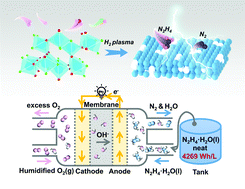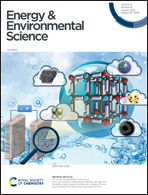Low-coordinated cobalt arrays for efficient hydrazine electrooxidation†
Abstract
Exploring advanced electrocatalysts for the hydrazine oxidation reaction (HzOR) could expedite the applications of direct hydrazine fuel cells (DHzFCs) for zero-carbon economics. Herein, we report a remarkable HzOR electrocatalyst based on low-coordinated Co arrays supported on Cu foam (p-Co/CF). The low-coordinated Co arrays were synthesized by the reduction of the Co(OH)F precursor with H2 plasma to induce numerous few-atom vacancies, producing low-coordinated surface Co atoms as catalytic active sites. The as-prepared p-Co/CF electrode exhibits a low onset potential of −0.15 V (vs. RHE) and a small Tafel slope of 8.83 mV dec−1 in 0.05 M N2H4/1 M KOH electrolyte, which are superior to those of most reported electrocatalysts toward the HzOR. Density functional theory (DFT) calculations have been employed to elucidate the HzOR process on metallic Co catalysts, suggesting that the improved catalytic activity would be attributed to the weakened adsorption of N2H3* on low-coordinated Co sites. Benefited by the superior catalytic activity of p-Co/CF, a prototype DHzFC has been demonstrated to deliver a high open circuit voltage of 1.1 V and a maximal power density of 186 mW cm−2 at ambient temperatures. This work provides guidance for designing high-performance non-noble metal electrocatalysts toward viable direct hydrazine fuel cells.



 Please wait while we load your content...
Please wait while we load your content...